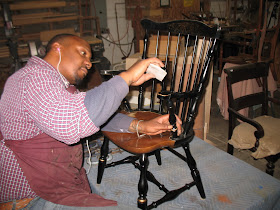 This beautiful chest just left our shop today, I am glad I got pictures of it before it went! It came to us with just a few problems, the first issue we had to deal with is that the top panel of the lid had shrunk. It was the correct size side to side, but small front to back. Because of all the intricate carving it would have been extremely expensive to add wood and carve to match. Instead we agreed to move the panel forward so that there was no gapping on the front, and then we colored the bare lip on the back so that it blended with the rest of the lid.
This beautiful chest just left our shop today, I am glad I got pictures of it before it went! It came to us with just a few problems, the first issue we had to deal with is that the top panel of the lid had shrunk. It was the correct size side to side, but small front to back. Because of all the intricate carving it would have been extremely expensive to add wood and carve to match. Instead we agreed to move the panel forward so that there was no gapping on the front, and then we colored the bare lip on the back so that it blended with the rest of the lid.Our next step was to clean and wax the entire exterior of the chest. In had some discoloration to the wood, where patches were lighter in color then the rest, and there was some odd whiteness in the carving. We still don't know what caused that or if someone at some point did it on purpose. But the Georgian Mahogany colored wax got rid of all of those color problems and gave the chest a gorgeous deep sheen.
The interior of the chest was very dry when it came into our shop. Not only did this do nothing for it's beautiful wood grain, but dry wood also brings a host of other problems. When the wood is dry, it is more susceptible to cracking and breaking, as well as shrinkage. (hmmm, could this have lead to that top shrinking?) Also, the pores are more open which means that they can catch moisture born issues and various molds.
We used two coats of Tung Oil on the interior of the chest which fixed the 'dry' problems and also brought out the gorgeous wood grain patterns. I almost think this trunk should just be left empty so that the marble pattern on the bottom can be properly displayed and admired! I know that will not happen so instead we can all just admire it in this picture.
Our customer was thrilled when she saw the finished result. It is reactions like that, that make our work so satisfying. We love a happy customer.

























